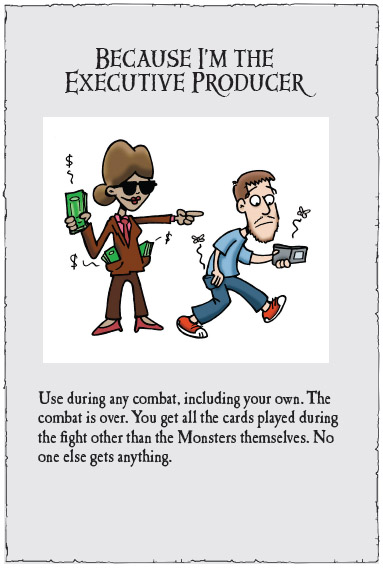THE CHARITY RULE
Colm Lundberg
Irish people, social bunch that we are, love poking fun at ourselves and each other. You know you’ve been accepted by the Irish community when we start to playfully insult you. No offense is intended; it’s the way we communicate, the ubiquitous Irish craic. Munchkin, being a silly game (in the best sense of the word), plays right into that. The charming art, the self-deprecating card text, the daft things that happen during play – like when a hero fails and ends up wandering around holding a duck – all appeal to that style of interaction. Hindering a fellow player in combat through the timely use of a “Pretty Balloons” card or other forms of outright backstabbing fits well, too, as long as it is done in good humor.
There is more to Munchkin’s local success than just fitting into the Irish mind-set, though. Munchkin is one of those games that allows people to bond in a fun way, without recrimination for treachery. Its humor creates a space for people to share in-game jokes: all that communal laughter generates instant friendships!
Munchkin has so pervaded the Irish gaming community that it’s not unusual at all to hear con-goers singing “Chicken on Your Head” to the tune of Rage Against the Machine’s “Bullet in Your Head” or “Snails on Speed” to the tune of Duran Duran’s “Girls on Film.” To be certain, there are people who take their Munchkin seriously, but most Irish gamers prefer to have fun with the Potted Plant rather than debate over who should kick it out the door first. I can honestly say that I have never been to an Irish convention where at least two sessions of Munchkin have not been going on at the same time, in different areas of the con, from side tables to demo tables and even in the pub.
I do not wish to add credence to the tired image of the “drinking Irish,” but the social elements of our conventions are vital to their success. We gather as one community, one family, and enjoy ourselves dancing, drinking, gaming, and chatting as one manifold organism. And it is not a closed organism. One true representation of the Irish that we hear echoed from overseas is our welcoming nature, and at our gaming cons we have adopted many people from England, Scotland, the U.S., and even as far away as Israel. We come together in everything from pub quizzes to our famous charity auctions.
In fact, for many gamers these charity auctions provide the key social event of the convention. They’ve even gained an international reputation, reflected most clearly in their recognition in 2006 with the prestigious Diana Jones Award. This is an annual juried prize for “excellence in gaming,” chosen by a mostly secret committee of industry notables. Munchkin is a crucial part of the auctions, but before I can show you how, you should understand more about how we run our conventions and our auctions.
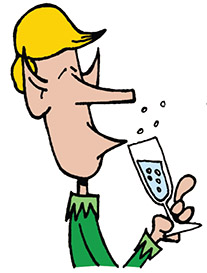
Let’s begin with our approach to guests of the convention. Rather than provide a rigid timetable of panels and a fixed schedule of events, we simply provide the guest a table, if they want one, and ask them to enjoy themselves. We feed and water them and make sure all the beer they get at the evening events is free. This initially leaves many guests astounded, since it’s not the way most conventions work, but this approach allows them to become part of the community, play games they enjoy, and generally have (we hope) a fun, relaxing time. Our guests seem to like it.
Steve Jackson has been over here a few times. He was here at one notable Gaelcon in Dublin in October 1993 where the entire committee was leveled by a horrible flu. Only one or two committee members were able to attend each day and they were barely functional. Fans of the game Illuminati: New World Order will know of the quite rare “Irish Flu” card that came about from Steve’s experience that year. There are other stories from 1993 about Steve and nightclubs that are probably best left to another time. . . .
Flu outbreaks aside, our convention guests often want to return, and when they do, they bring amazing lots to add to the charity auctions. Both Steve and Munchkin artist John Kovalic have seen the charity auctions in action firsthand. The mood of the event was so, dare I say, infectious, they even jumped onto the stage to join in as compères – or masters of ceremonies. Because I’ve had the honor of hosting the auction at the Gaelcon games convention for many years, serving as compère, I had the pleasure of sharing the stage with these crazy guys.
Running an auction of this kind is a uniquely humbling experience, and it’s impossible not to be moved by the generosity the gaming community demonstrates through these events. We gamers spend our hobby time playing heroes. From our first choose-yourpath game books to more in-depth roleplaying creations, we often want to play a character who makes a difference. The people who make these auctions possible give freely of their valued collectibles and offer bids to the maximum of their bankrolls. They are heroes. Most of them are quite humble, but raising over €30,000 at a single charity auction in the salad days, and even reaching over €15,000 in these recessionary times, is a pretty impressive achievement in anyone’s book.
Let me give an example of the type of bidding that goes on:
- €1,200 for the right to be represented on artwork for a Munchkin card;
- over €1,000 for a copy of the old fanzine Owl & Weasel;
- €1,000 for 100 different comics, all less than a year old;
- €150 for some toilet paper I bought in a discount shop for €2;
- €50 to slap me;
- €800 for two bottles of whisky, one of which the bidder then put back into the auction to resell.
We tend to use the money raised to support children’s charities, and much of the money goes toward buying games and toys. After the auctions conclude, the committees take photos and gather stories of where the money was spent, and bring both to the following year’s event. One year, I was humbled to be there to provide a check to an Irish charity that provides therapy and support to young victims of sexual abuse. Posters made by the children lined the walls of the office. One was done by a girl aged eight. I still remember it, and the emotions it evoked, vividly. It was a simple poster, one color (bluish-green), with a single, powerful sentence in red paint: I realize now it’s not my fault. I brought this picture to the following charity auction and put it on the projector behind me as I detailed its origins. People in the crowd began offering money before the first auction lot was even called.
The most Munchkin-focused charity auction in Ireland has to be at Warpcon in Cork, which runs every January. This is largely due to the regular presence of John Kovalic. John has attended so often that we see him less as a guest than as an errant friend who returns home for the show. John is a true gentleman, as anyone who has met him will attest, and the most obliging of people. He will sign and draw anything, on anything, for anyone (within the confines of legality and decency, of course). There was one year he could not attend, but he “deputized” me to be there in his place. It was the one year Munchkin products in Ireland went up in collectible value, since they were not signed by John.
John always comes prepared for the charity auction at Warpcon, often with original Munchkin artwork. (I am looking at the 10thanniversary artwork currently hanging on the wall of my study as I write this.) Charity lots of original artwork are usually snapped up for bids never less than €700. He has also brought Munchkin boxes, card-holding suitcases from Germany, and many other collectibles from the world of Munchkin, including cookies, water bottles, bobbleheads, helmets, miniatures, and cuddly toys to beat the band. Through the items he has brought, John has singlehandedly raised thousands at the Warpcon auction.
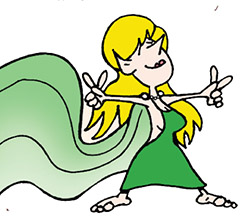
There is one event – and I think it is right to call it an event – that John stages almost every year that tops the billing at the show and has every gamer slavering at the opportunities it presents: the chance to be part of one of John’s published drawings. He has auctioned off the chance for people to be rendered as victims for My Little Cthulhu, a warm ‘n’ fuzzy Bringer of the End of the World, now also represented as a bonus card for the Munchkin Cthulhu set. The biggest draw, though, is the chance to be represented in a Munchkin card. That’s right. In some of the sets of Munchkin you have on your shelf, one of the monsters or treasures or trap cards contains the image of an Irish gamer.
This all started about a decade ago, if memory serves, just after Super Munchkin came out and before Munchkin 4: The Need for Steed was announced. After witnessing previous auctions, John presented the idea to Steve, who readily agreed. To give you a small sample of some of the cards Irish gamers have become: “Charisma” in Super Munchkin; “Bush Knife” and “Karate Training” from Munchkin Impossible; one of the “Super Munchkin” cards in Munchkin Booty (the pirate with a goatee and glasses, wearing red); as well as two cards won at the 2013 auction for Munchkin Pathfinder. The “Bush Knife” winner is an archaeologist, frequently in the field, and the “Karate Training” card artwork depicts an actual martial artist!

The battle to be part of a piece of published Munchkin art unfolds like this. The auction has been going on for a few hours. Some beer has been consumed, and the bidding can be likened to the interaction of a Munchkin game. People in the audience – and the folks on the stage – hurl random abuse to coax bids higher or force rivals to back down, all in good humor, of course. By this point, the compère has little idea what lot is next or who has bid for what. (His or her job is to keep the show moving, and other volunteers thankfully keep track of all that.) Sometimes items are suddenly added to a lot to make it more appealing. Bidders who are rivals one moment may find themselves pooling their funds as a team the next, in order to win a treasure that has risen in value above their individual purchasing power.
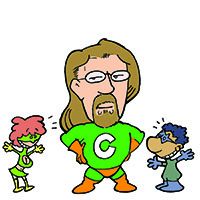
The atmosphere in the room swings between jovial and electric – the excitement of the bids building, the joy when a lot is won, the cascade of good feeling and camaraderie in the crowd. There are no losers in this scenario and everybody knows that. The people whose bids don’t come out on top always congratulate the winners and they act as what we are: a genuinely close community trying to raise money for charity.
Into this scene strides the giant that is John Kovalic. (For those of you who haven’t seen John in person, he is well over six feet tall.) He takes the microphone and an image of Spyke, the iconic Munchkin, flashes up behind him. John starts speaking, and as soon as he mentions the chance to be immortalized on a card, hands shoot into the air with four or five fingers raised – an opening bid of that many hundred euros. John calls the bids; the auctioneer tries to keep track of the sea of flailing hands. Quickly the bid moves toward the €1,000 mark. Things get a little more serious now and people start talking. Artistic representation on a second card is entered into the lot. Bidders look for help, joining forces to secure the prized lot. A few moments later, the final bid is called. The treasure has been won, and the bar erupts in a massive cheer. A stunned John Kovalic shakes his head in humbled bewilderment as a pint is pushed into his hand. John and Munchkin have done it again. Winners of bids are grinning broadly, standing proud as the staff takes their details so John can arrange appointments for poses.
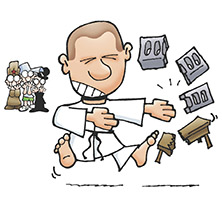
The chance to be featured on a Munchkin card has never earned a final bid below €1,000. Sometimes there are two cards, allowing a pair of gamers to combine resources and still take one card each. These lots have often gone for €1,500 or more. So we have the killer combination of the social community of gamers, a good cause for charity, Munchkin, John Kovalic presenting the lots in person, and a healthy sprinkling of Murphy’s or Beamish. (Never drink Guinness in Cork; the aforementioned stout breweries are local.) The bidders’ wallets never really stand a chance – and they couldn’t be happier about it.
Hobby gamers tend to personalize the games they enjoy, whether through house rules or by creating their own special storage cases for beloved titles and their expansions, but the Irish charity auctions afford devoted Munchkin fans a way to personalize their favorite game in special ways. Steve, John, and everyone at the company have been remarkably gracious in their support. It always makes me smile to think that there is a small part of the Irish game convention scene enshrined as part of the world of Munchkin. And because that facet is linked so intimately to charity and doing good for children, that connection is a +1 for us all. 


Colm Lundberg is a budding Irish writer who has been prominent in the Irish gaming scene for over 20 years. He’s spent a lot of that time running charity auctions. He has also run charity auctions in the U.K., sharing a stage with James Wallis, who made a £50 charity donation to make Colm chug £3 fizzy wine. He has yet to forgive James. He managed to escape the capital city for more rural climes, currently living in the wilds of County Kerry with his wife Jen. They have a rescue dog called Scooby. (He is nothing if not original.) Colm has worked for Steve Jackson Games, has been a member of the MIB (Men in Black, the Steve Jackson Games convention support team) for over 15 years, and has learned many secrets during a stint as MIB Control. It is purely coincidental that he also works for the Irish government. Colm recently became a real-life game designer with his first game, Love 2 Hate from Green Ronin, and, no, he still doesn’t know how.
